1lumen selects and reviews products personally. We may earn affiliate commissions through our links, which help support our testing.
Cyansky H3 review
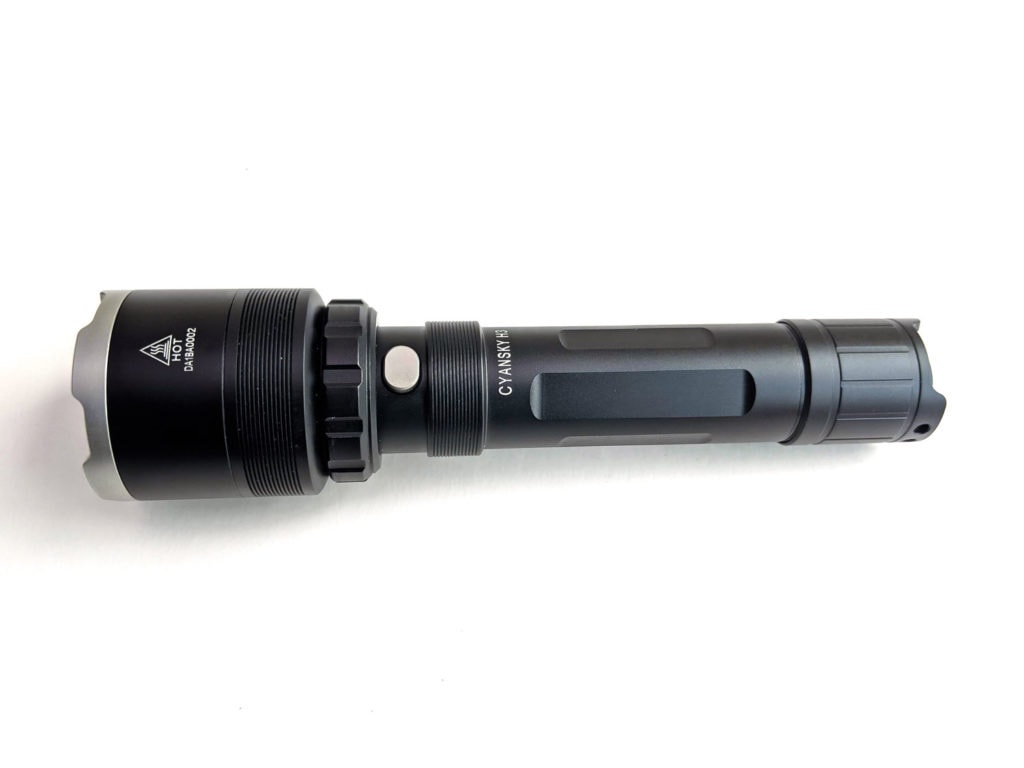
Cyansky H3 specifications
| Brand/model | Cyansky H3 |
|---|---|
| LED | CREE XHP35 HI |
| Lumens | 1,300 lm |
| Beam intensity | 40,000 cd / 400m |
| Battery config. | 1*21700 |
| Material | Aluminum |
| Modes | 4 |
| Blinkies | Strobe |
| Reflector | OP |
| Waterproof | IPX8 |
| Review date | April 2021 |
Introduction:
Here we have the new Cyansky H3. Freasygears (owners of the Cyansky brand) call this a “Multi-color Long Range Hunting Flashlight”. The multi-colour aspect is the most interesting part and why you might want to buy the H3 over other flashlights. I’d classify the H3 as a small tactical thrower.
It’s actually a very similar flashlight to the Cyansky H5, which we reviewed a few months ago. The H3 is smaller and throws 400m, instead of 600m. Both the H3 and H5 share the same LED and max lumens, as well as UI, switch and body tube.
This light can output white, green and red light, from the white LED thanks to the use of a patented built-in filter. There aren’t many lights that can do 3 colors. Most others use separate LEDs, which means they either don’t throw as far or the LEDs are off centre. Cyansky suggests that the green colour can be used for hunting feral hogs (wild boar) and the red colour can be used for deer and coyotes.
Package quality.
The H3 comes in a laminated cardboard box with foam inserts for protection. As well as the main box, I received a gun mount and remote switch in the package. These seem to be optional extras, just like with the H5.
The remote tactical switch replaces the tail cap and includes both a forward-clicky switch and a momentary-only switch. The switches attach to a gun with a standard dovetail rail, though also works perfectly fine without a gun.
The main gun mount I received is different to what Cyansky shows on their website. Instead of a rail mount it’s an adjustable double tube mount, which takes tubes between about 25-32mm. The closest thing I have to a rifle is a broom, which fits solidly – I’d expect it to mount to a rifle fine too. You could also use this to mount a light to a bike but it would point sideways if attached to handlebars.
In the box, there is
- Cyansky H3
- 21700 Battery with built in USB-C charging
- 1 spare o-ring
- Spare tail cap
- Manual
- Warranty card
- Holster
- USB-C cable
Optional extras:
- Gun mount
- Tactical switch
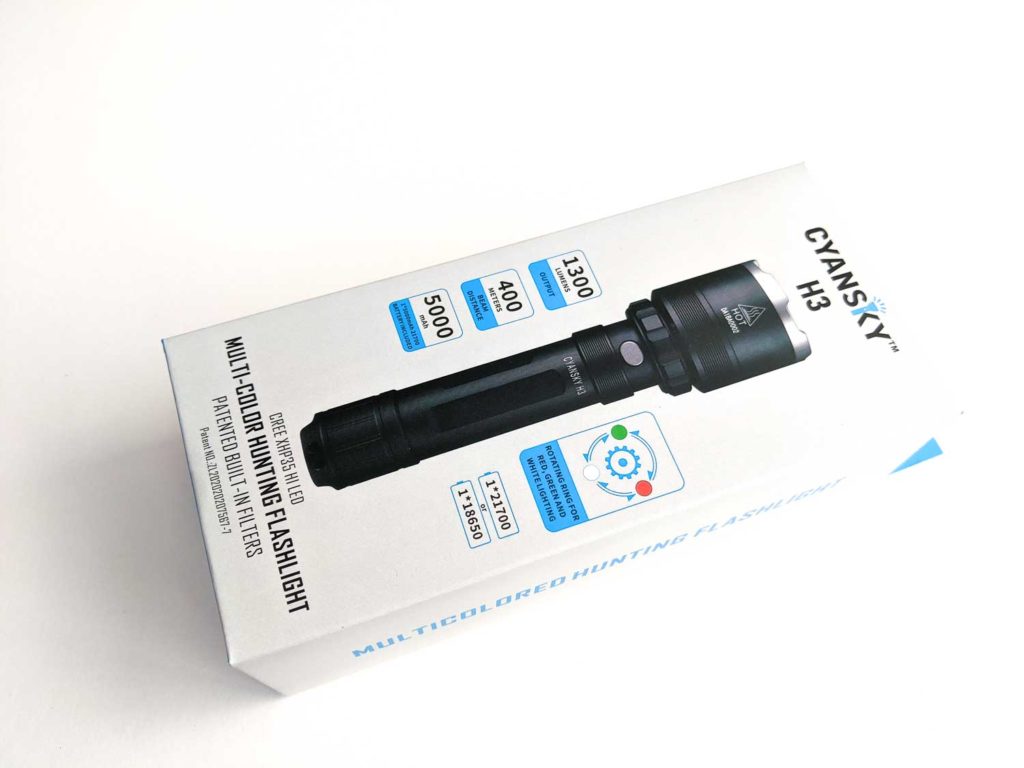
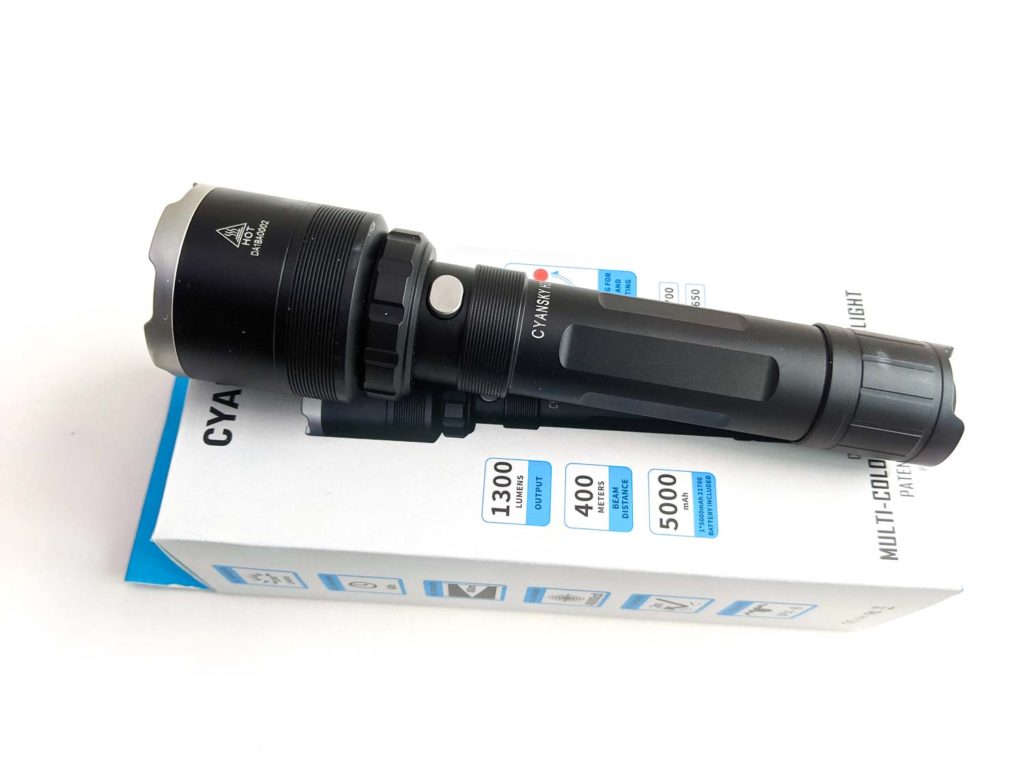
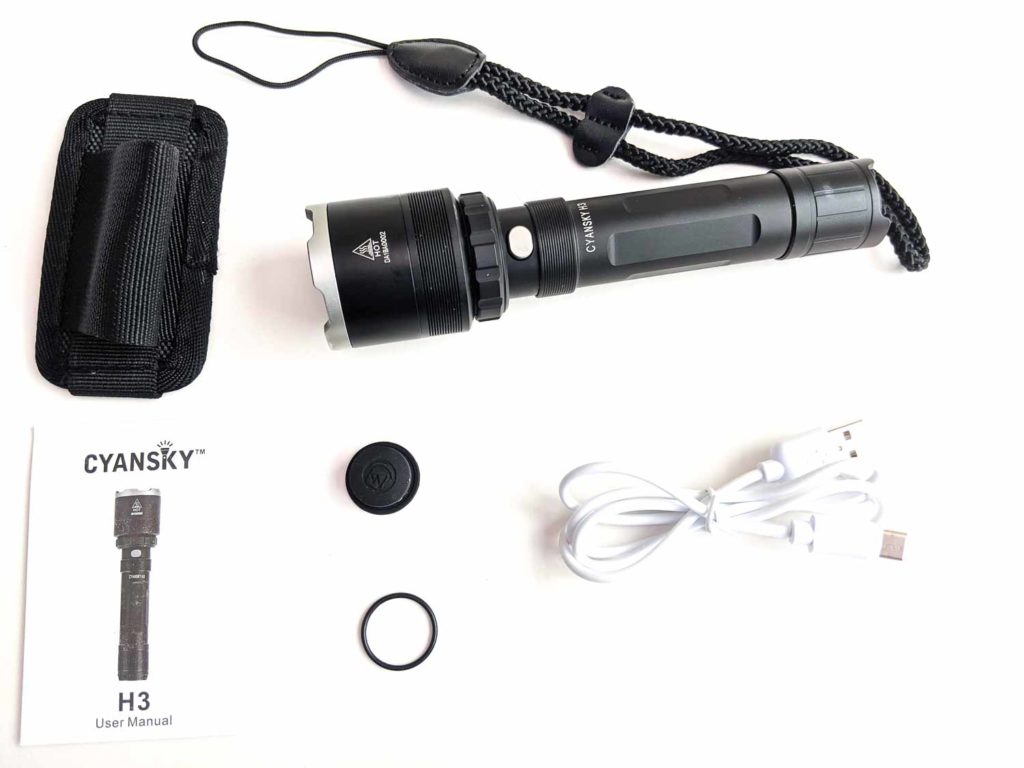
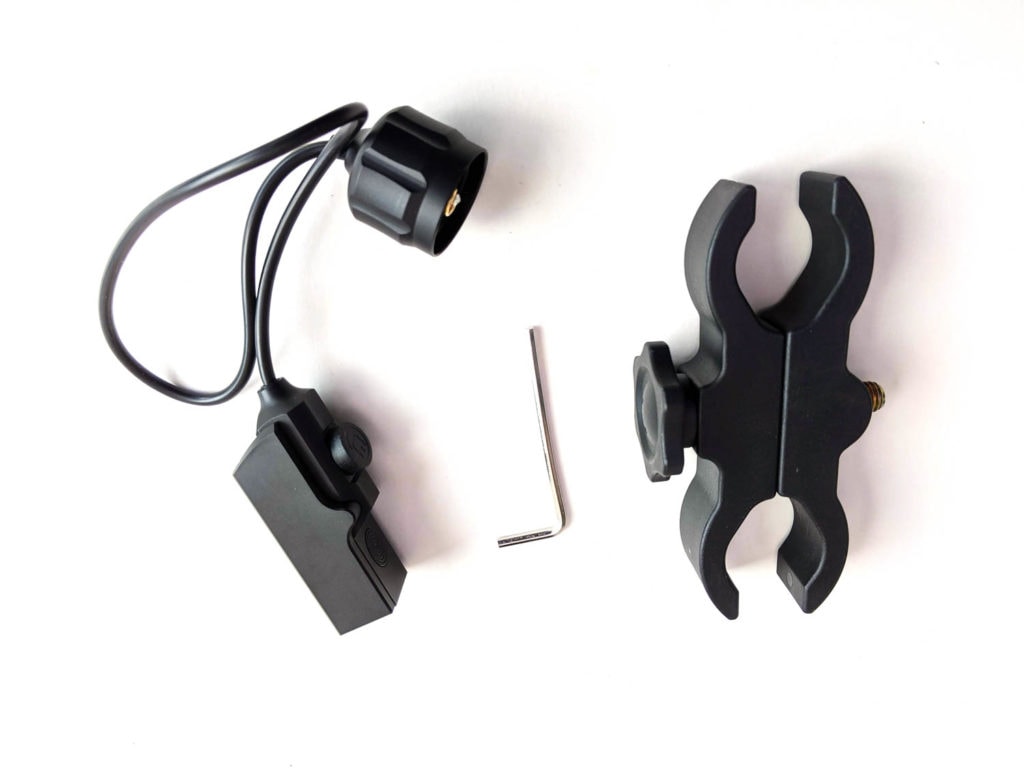

Flashlight in use
Just like the H5 (I keep having to say that), one of the first things you’ll notice when you pick up the H3 is how slim the body tube is. At 23.9mm at its slimmest, it’s barely wider than some 18650 lights.
There’s no knurling on the body tube but the tail cap has light grooves for grip. The head has knurling that looks a bit like heat fins but are more like fine threads. Whilst it’s smooth, the light is still fairly easy to grip due to the slightly larger tail cap.
The H3 has 2 switches and a rotating control for the filters.
The physical switch is a forward-clicky, which is standard for a tactical light as it provides momentary on with a half-press. It’s easy to press with a thumb as the tail cap has indents.
The grey e-switch sits proud and is easy to find. It’s easy to reach with a thumb but a challenge to reach when your thumb is resting on the tail switch. With a bit of practice, I can reach the e-switch with my baby finger whilst my thumb is activating the tail switch. More about the UI later on.
The rotating filter control is clever. It seems a bit like a magnetic control ring. It has a 2:1 gear to rotate between the 3 options: no filter, red filter, and green filter. These all have their own mini reflector. This is a moving physical mechanism that joins the inside and outside of the light so it’s a potential point of failure. The light is rated IPX8, so should be waterproof but I’d be cautious of water ingress here. There’s about 2mm of play as it rotates but as you turn it round it kind of locks each filter into place. When locked in, the mini reflectors are aligned nicely, with the LED being well centered. The light output dims as you rotate between the different colours, as the solid part of the mechanism blocks the LED.
There’s no anti-roll feature and the light will very easily roll when it’s on a table. It will tail-stand but could easily get knocked over as it’s top-heavy. The holes for the lanyard attachment are on the side, which doesn’t stop it tail-standing when the lanyard is attached.
The holster is a few bits of nylon stitched together. Nothing special but it works well enough. The holster will fit on a wide belt and would fit most 18650 or 21700 lights. The H3 is a little loose in the holster but would probably only come out if you were somersaulting.
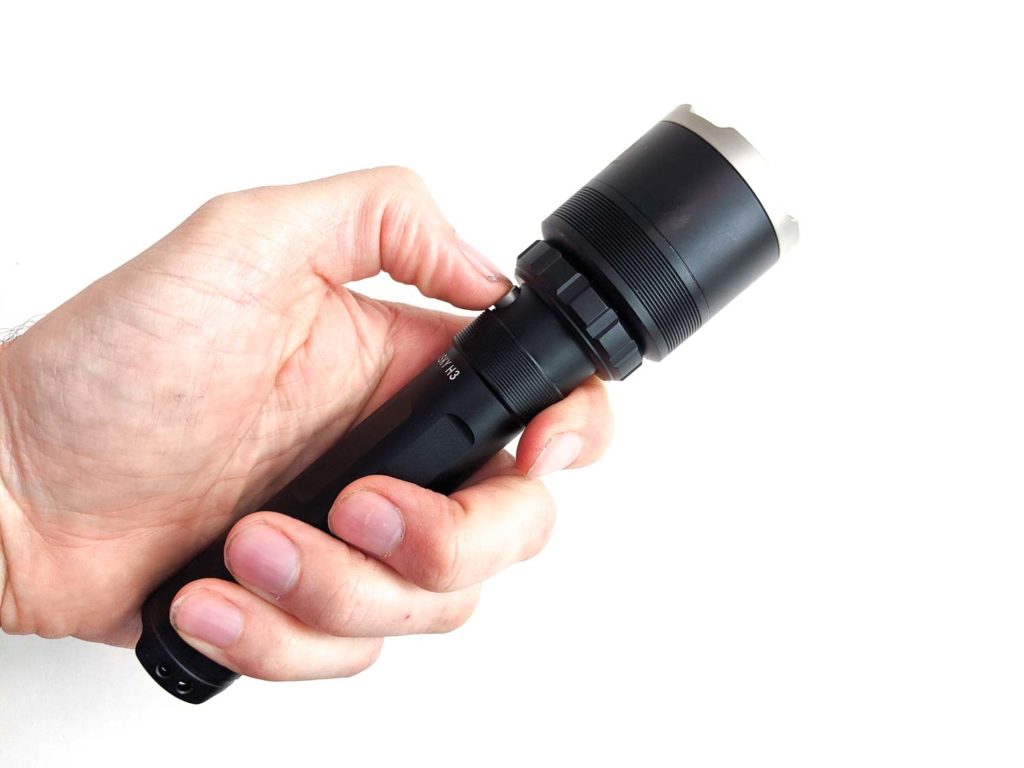
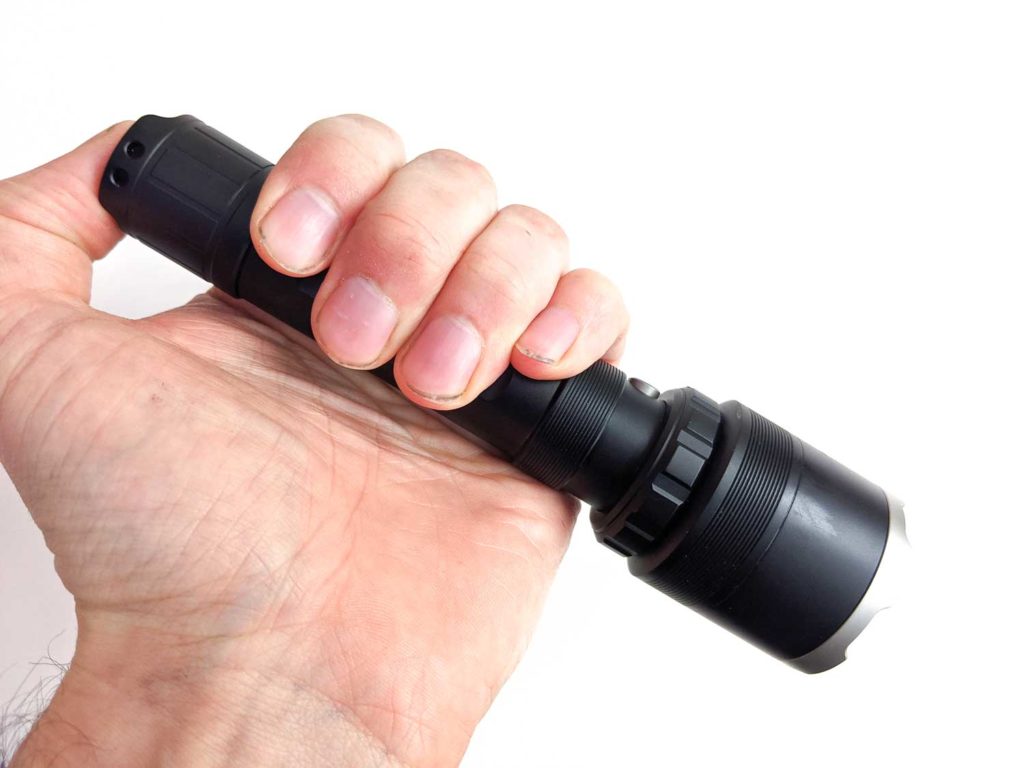
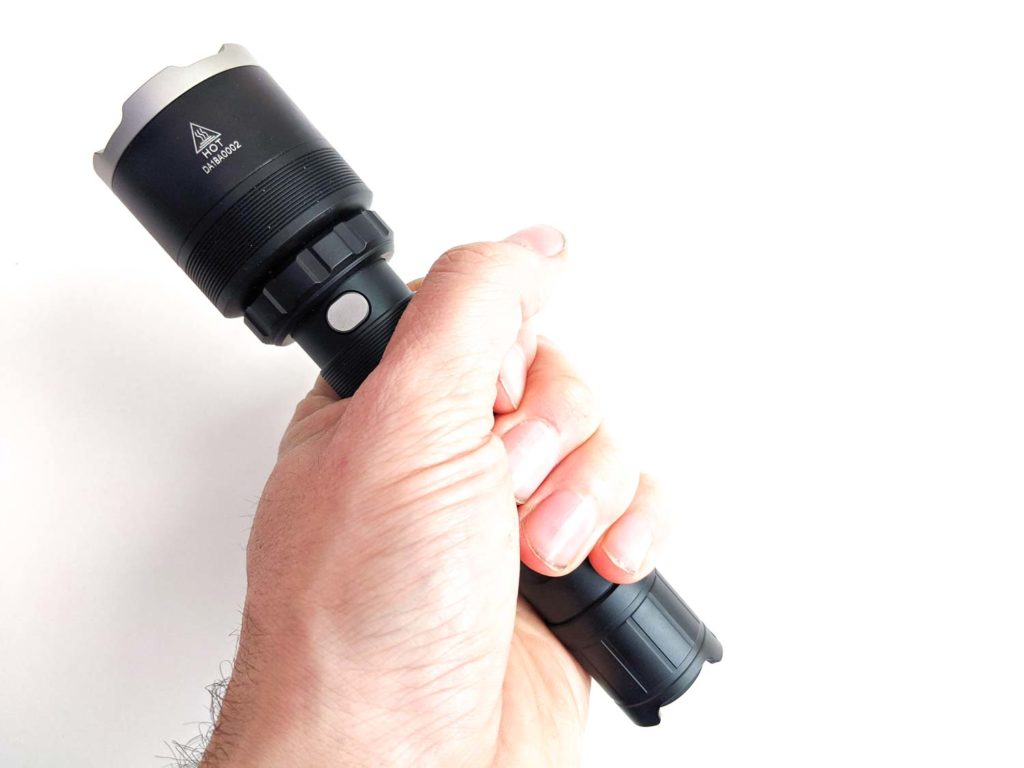
Build Quality, and Warranty
The H3 feels and looks like a well-built aluminum light. It’s better balanced than the H5, as the head isn’t so heavy.
There’s a normal spring at the tail end but strangely, there isn’t really a spring on the head end. This doesn’t seem to affect the light though and the H3 kept the circuit connected, even when the light was knocked. This could have been intentional from the start or it might be that this was a last-minute change so the light could accept 21700 cells with built-in charging circuits.
The H3’s tail spring isn’t bypassed on the normal tail cap but the spring on the remote switch accessory is. With the H5, the tailcap had to be screwed tightly for turbo to last more than a second. The H3 doesn’t have this issue at all.
The anodization is shiny back MIL-A-8625 Type III.
The threads are square-cut and well lubed. On the H5 review you can see that I unscrewed the head from the body. The H3 doesn’t come apart so easily, so I haven’t forced it. I expect it would but as the driver end looks and behaves identically I haven’t forced it.
Freasygears provide a manufacturer’s warranty. You get 15 days free replacement for any manufacturer defects. They also give a generous 5-year warranty for repairs under normal use.


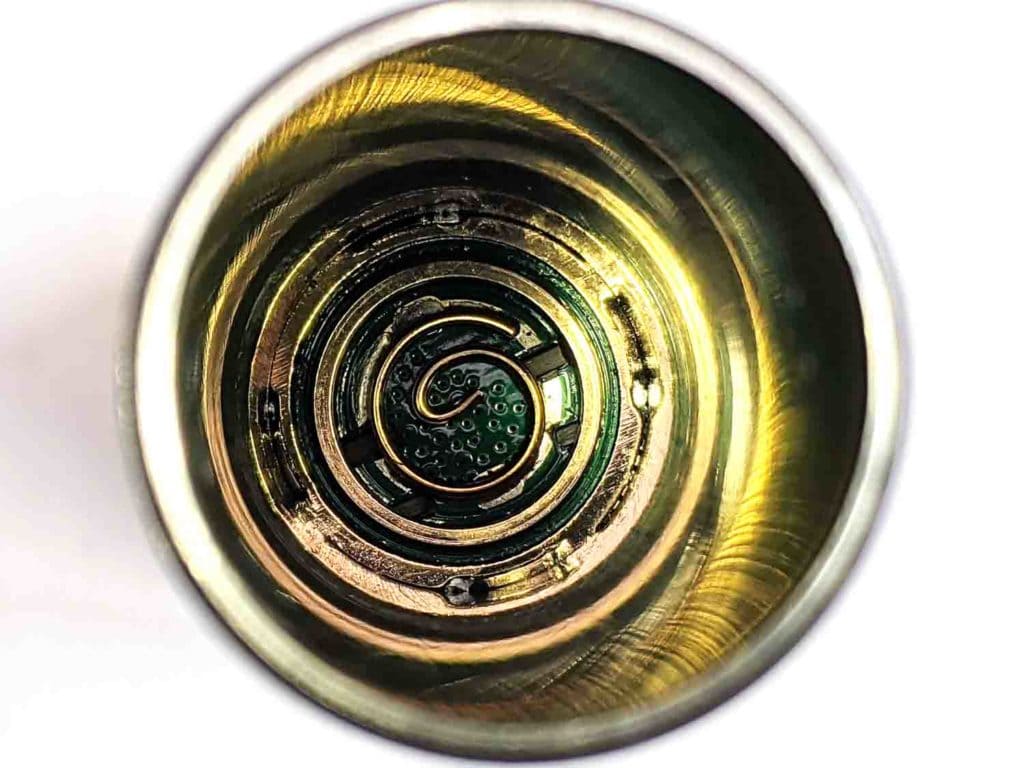
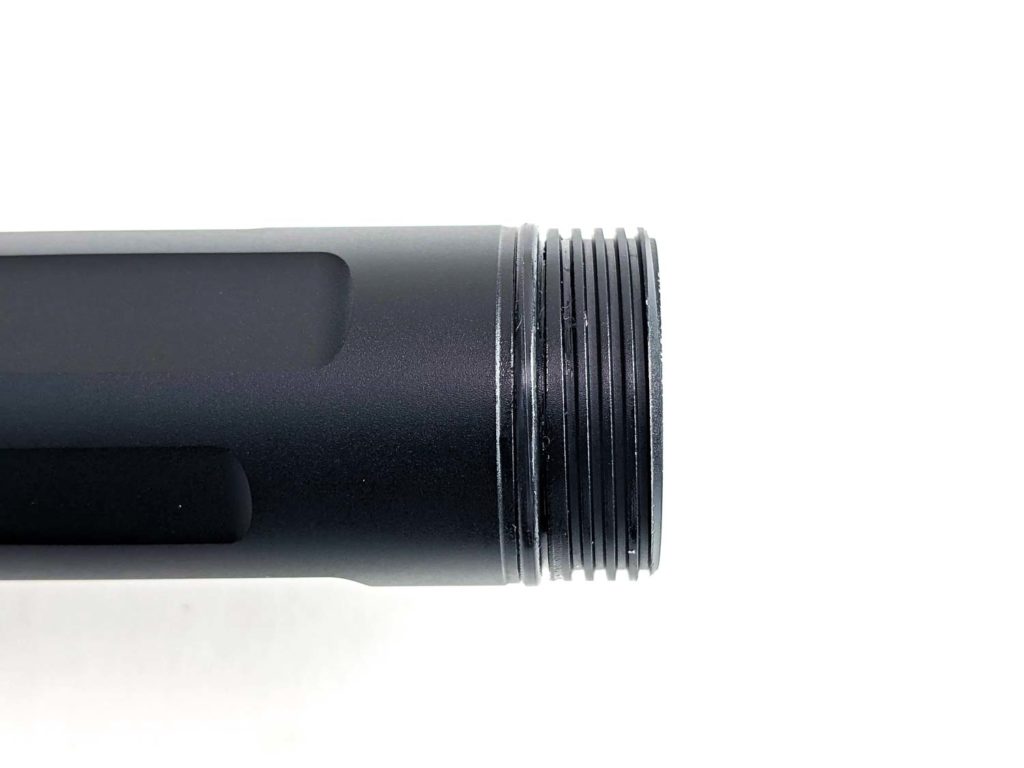
LED, Lens, Bezel, and Reflector
The Cyansky H3 comes with a CREE XHP35 HI D4 LED, the exact same one as the H5. In fact I’d go as far to say as the H3 and H5 are identical from the LED down to the tail cap.
The XHP35 is a good choice for a long-distance flashlight. This is a 3535 sized LED but it’s 12V, so can’t be swapped easily with a more common 3V one. The LED is the HI (high intensity) version, which means it doesn’t have a dome and will throw a bit more. The bin is listed as D4 bin, which is the low-mid CRI and higher lumens per Watt. Some flashlights drive the XHP35 to 2000 lumens, so 1300 from the H3 shouldn’t be pushing it too much. The color temperature isn’t mentioned but it looks to be around 6500K compared to other known flashlights. It looks just a very tiny bit warmer than the same LED in the H5, which is probably down to bin variation.
The beam looks white and even all over, though there’s a very slight yellow tint around the hotspot (unlike the H5). This is only noticeable when pointing at a white wall.
The main orange peel reflector does a good job of evening out the light and the mini reflectors in the rotating mechanism don’t seem to cause any unwelcome beam artifacts. The main reflector is 25.7mm deep and has a maximum internal diameter of 31.2mm.
The bezel is silver-colored stainless steel. It’s coated in something, so it’s not as reflective as some bezels. The bezel is lightly crenelated, which means you can see if you left it on whilst head-down.
The beam profile is fairly throwy for its size but I wouldn’t call it a “thrower”, at only 400m. It’s more like a throwy tactical light.
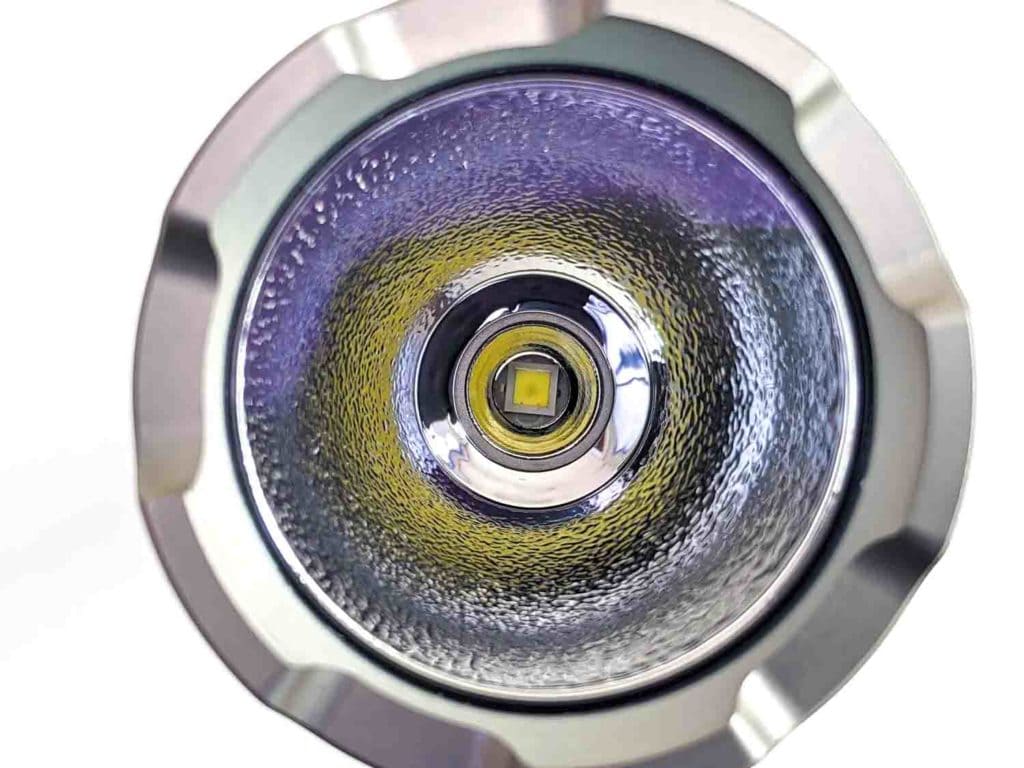
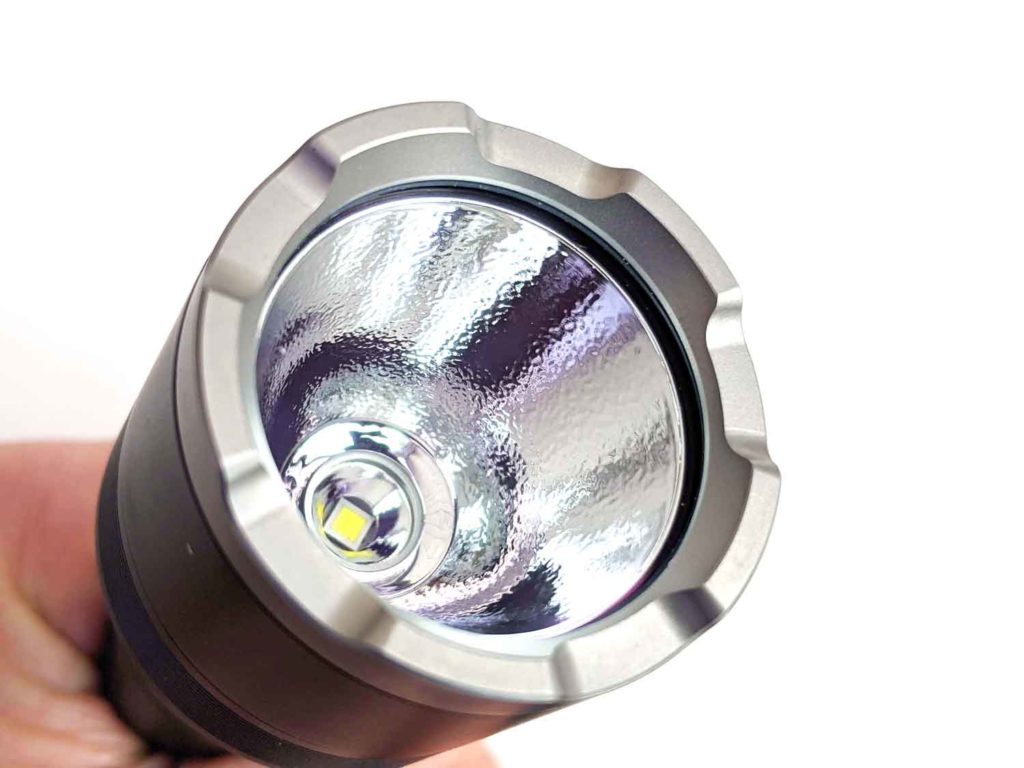

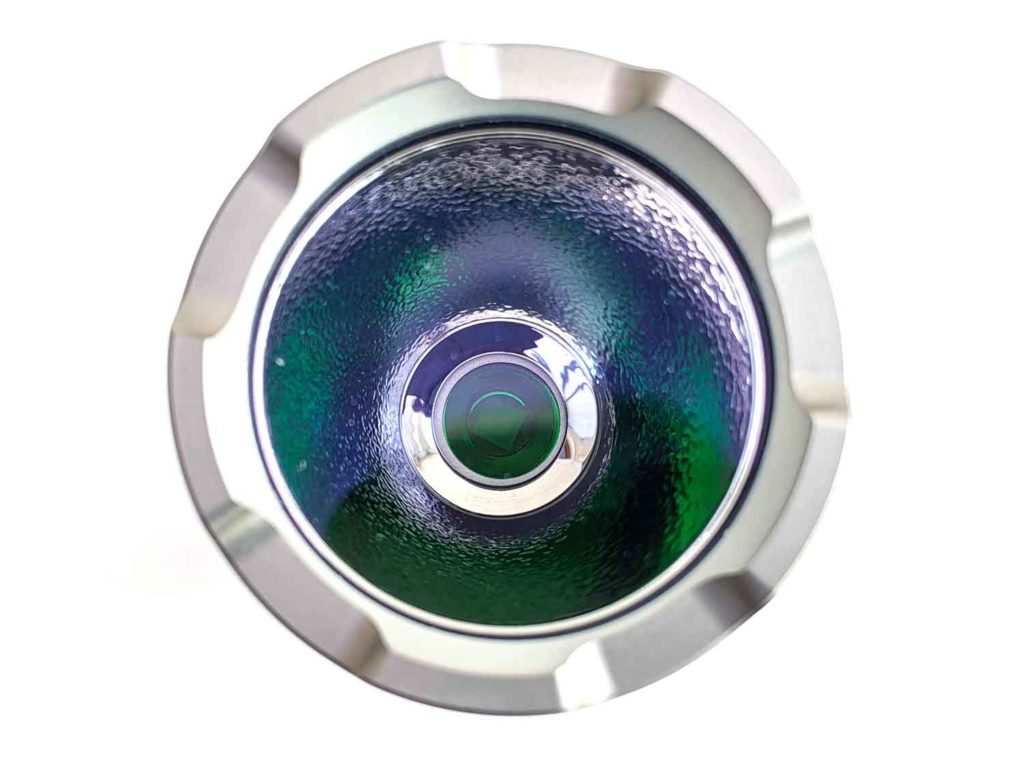
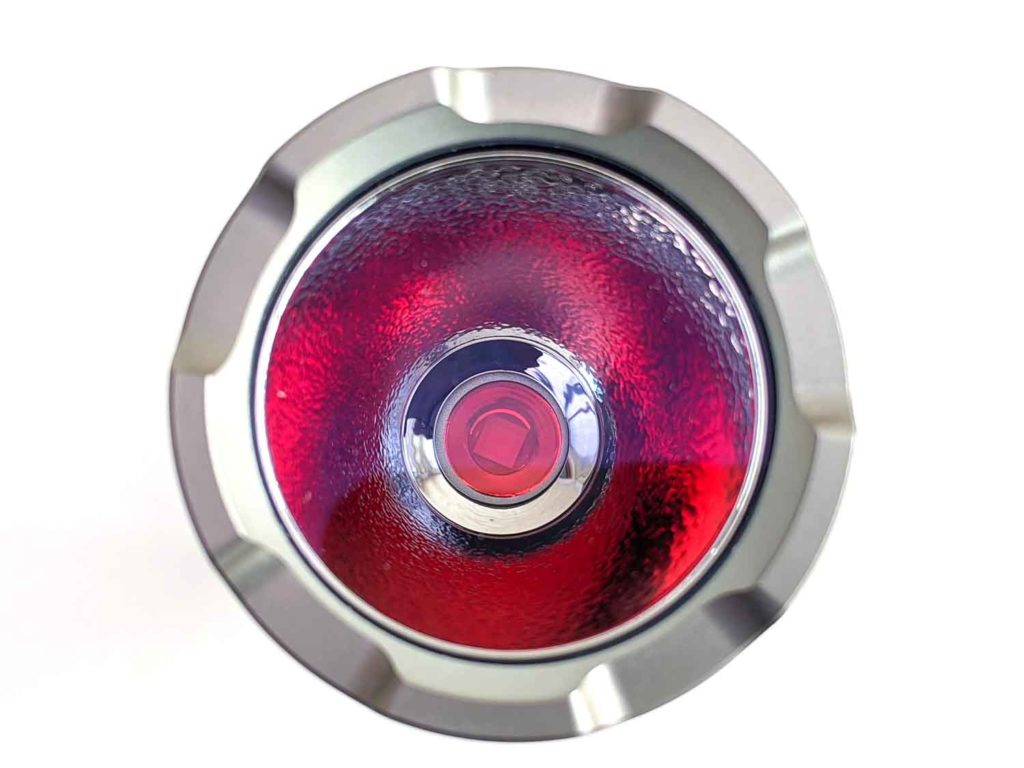
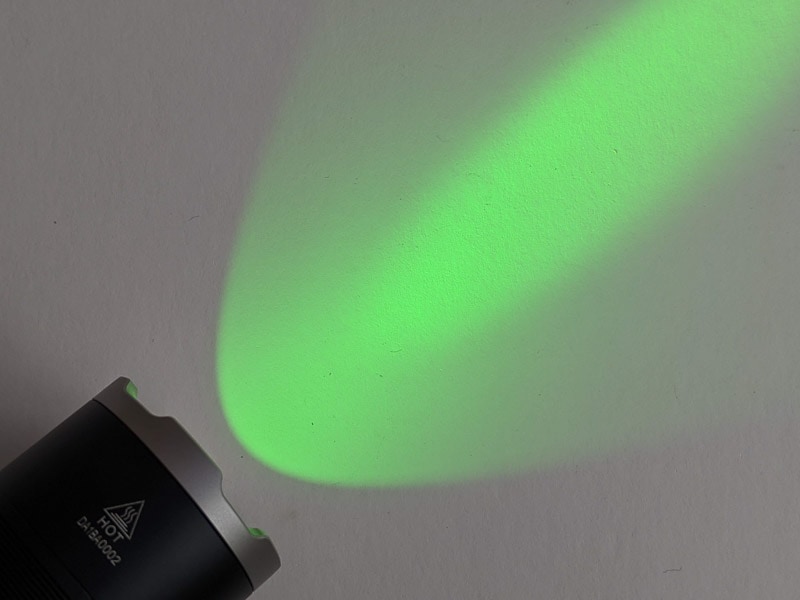
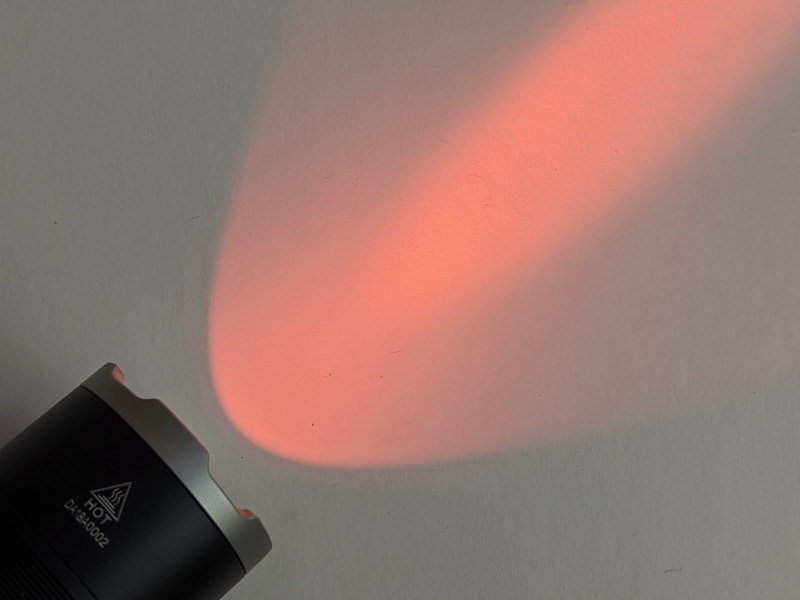
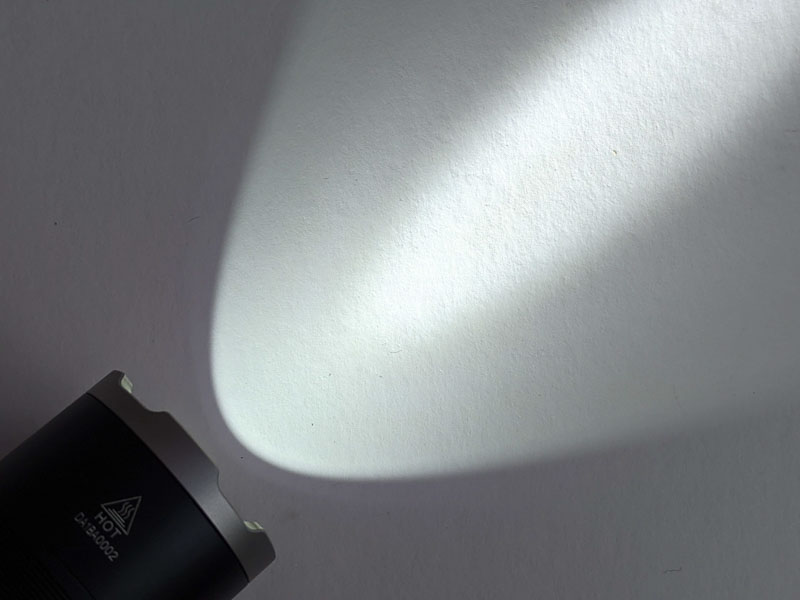
Dimensions and size comparison
- Length: 16.71cm / 6.57 inches
- Head diameter: 4.14cm / 1.63 inches
- Body diameter: 2.39cm / 0.9 inches
Weight:
- With cell: 240g / 8.4 oz
- Without cell: 166g / 5.9 oz
Flashlight size comparison
Compared to its big brother, the Cyansky H5.
Small thrower / tactical flashlight comparison:
- Sofirn SD05
- Convoy Z1
- Cyansky P25
- Cyansky H3
- Cyansky H5
- Convoy M3-C
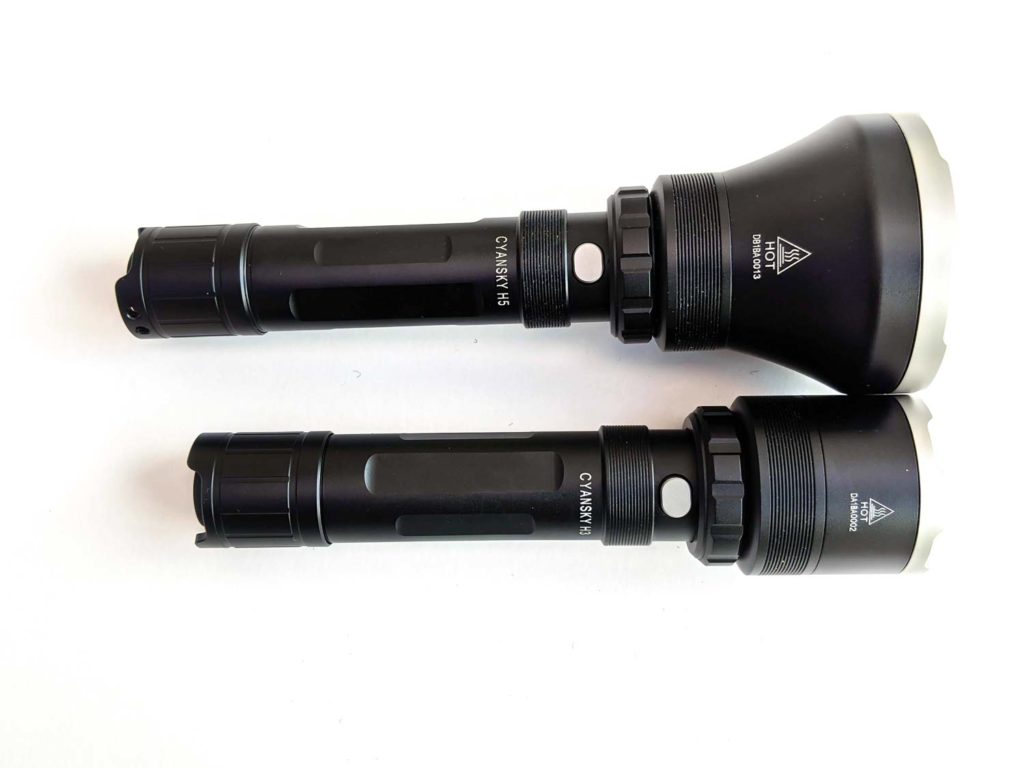
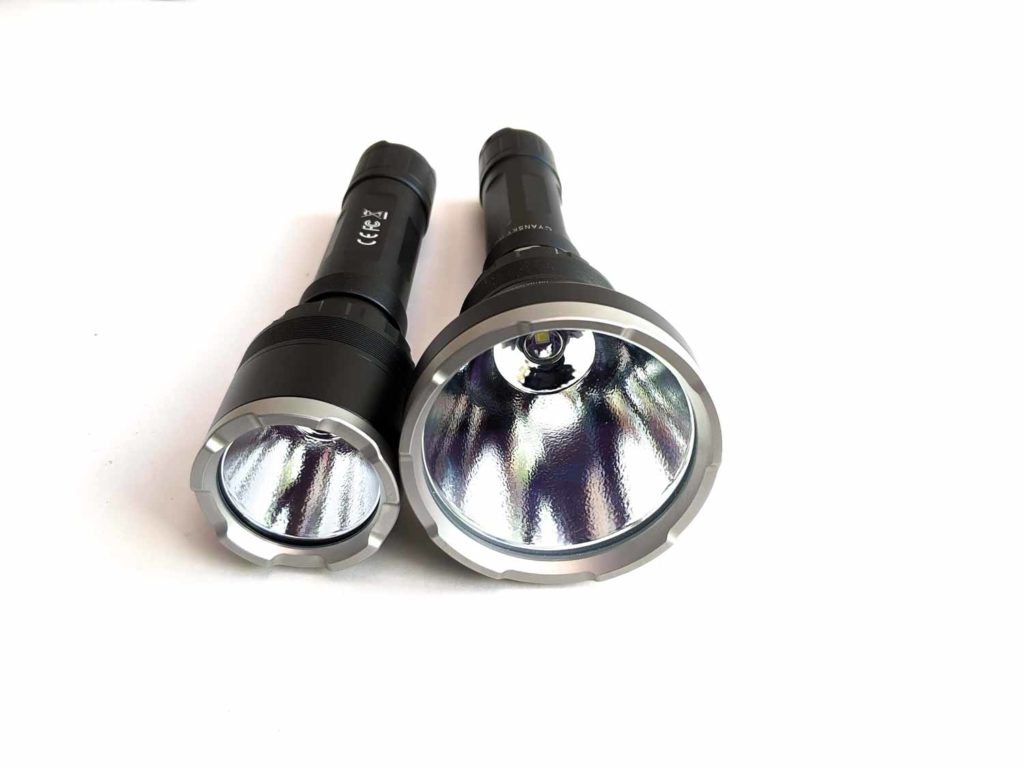
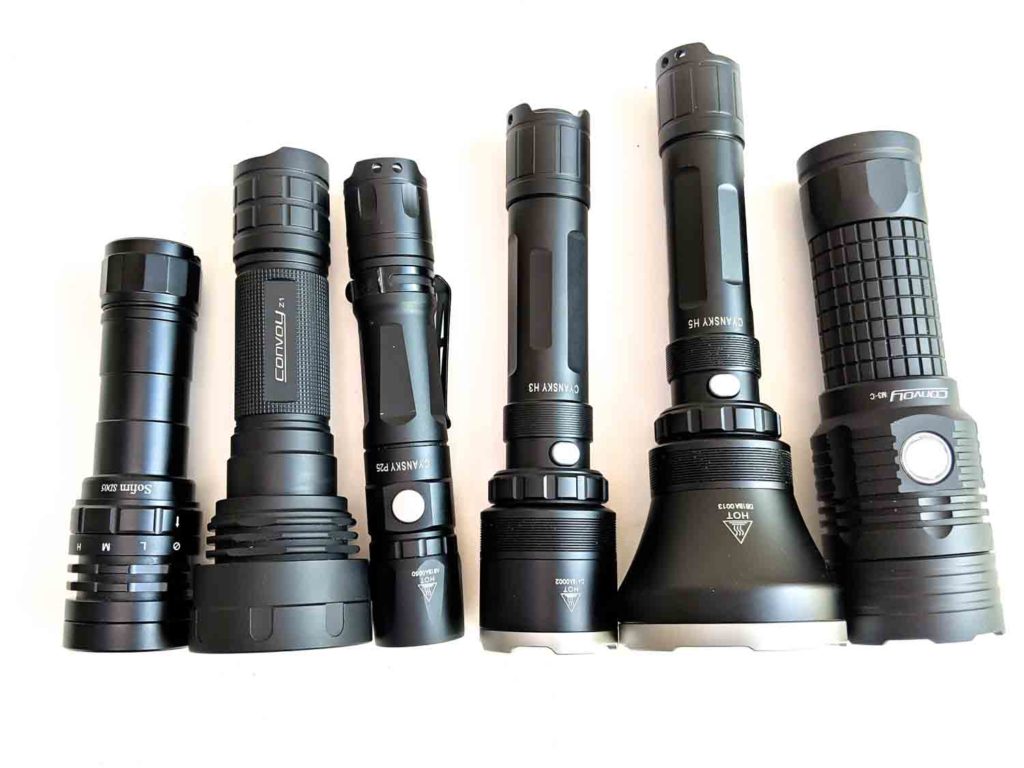
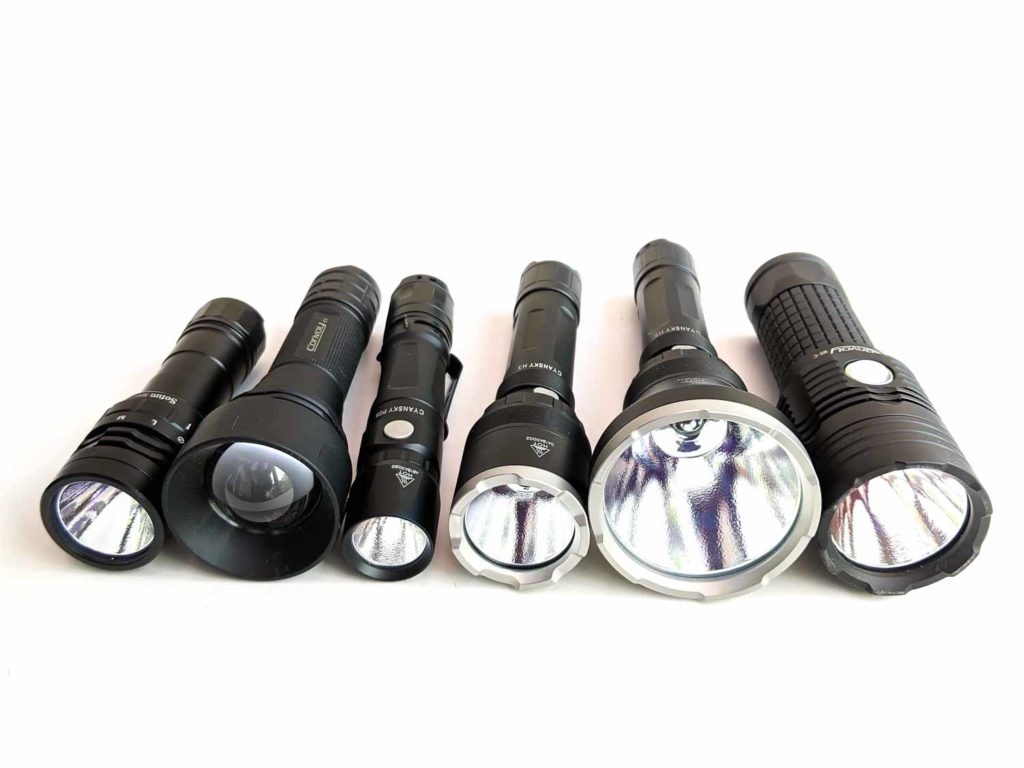
Driver & User Interface:
Modes: Low, Medium, High, Turbo, Strobe
The UI on the H5 is pretty basic, thanks to the 2 switches. The forward-clicky physical button only turns on and off – either momentarily with a half press or permanently with a full press.
The e-switch only changes modes and doesn’t turn the light on/off. There’s no double / triple click or configuration options like some e-switch lights have, so it doesn’t take long to explain how it works when lending to someone.
The H5 has mode memory, which is very useful for momentary use with the physical button.
The other part of the “interface” is the rotating ring to switch the filters. You can pick from no filter (white), red or green.
From ON:
- Single click: change mode: low, medium, high, turbo, then back to low
- Hold: activate strobe
- Physical switch turns off
From OFF:
- E-switch doesn’t do anything
- Physical switch turns on
From strobe:
- Click or hold: go back to last normal mode
Short cuts:
- To Strobe: hold the e-switch
Lock-out mode:
- There’s no lockout mode but the tail cap can be unscrewed slightly to stop the light turning on
PWM
- I couldn’t detect any PWM on any modes with the H5. This is as to be expected, as the H5 uses a constant current boost driver to step up the cell voltage to 12V.
Batteries & Charging
The Cyansky H3 comes with a button top 21700 cell that includes a USB-C port for charging. This is the same “BL2150U” cell that Cyansky ships with the H5.
The cell is 76.2mm long, so won’t fit in many chargers. I have mixed opinions about putting the charging circuit on the cell. Having it on the cell means the flashlight can be more waterproof but also means that you can’t switch cells so easily. That said, I tried a couple of standard flat top 21700 cells like a 30T and they seemed to work fine. It even worked with a button top 18650 but not a flat top one.
The H3 says it also works with 2*CR123A but I didn’t have any to test.
The 21700 cell’s built in charging seems to work well, starting off around 1.5A using an A-to-C cable, then trailing off as it got near full capacity after a bit over 3 hours. The cell has a little LED on the top: red for charging and green for complete (sorry color blind people). The circuit stopped charging at 4.22V.
The cell charged via a C-C cable too, which was a nice surprise.
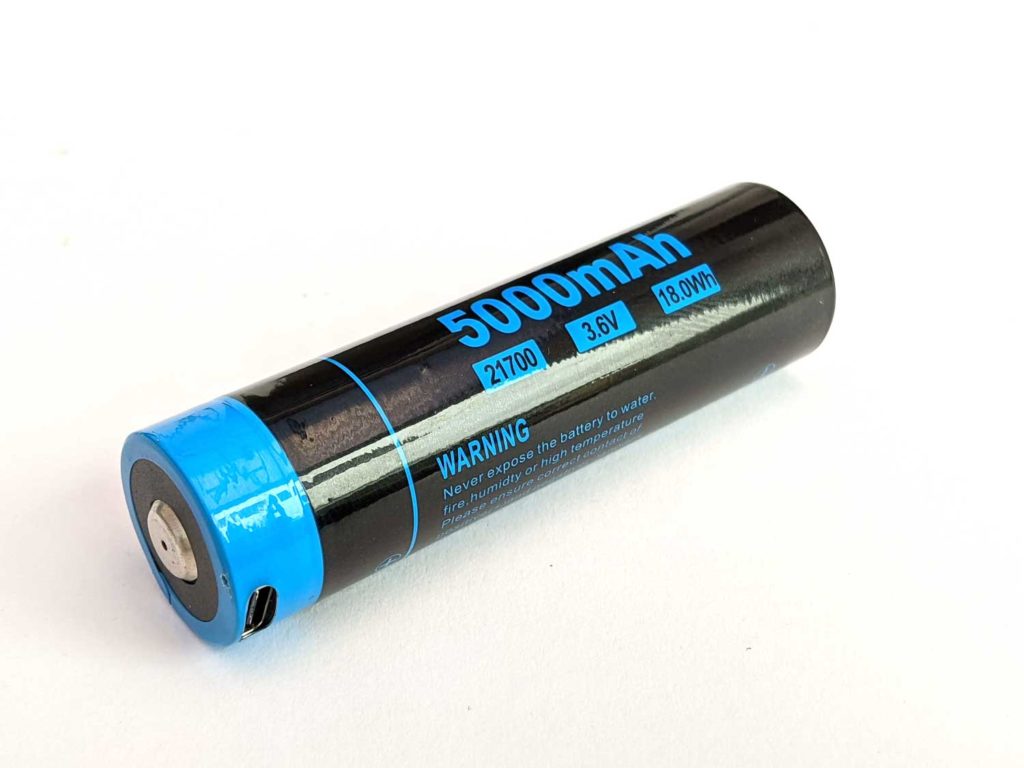
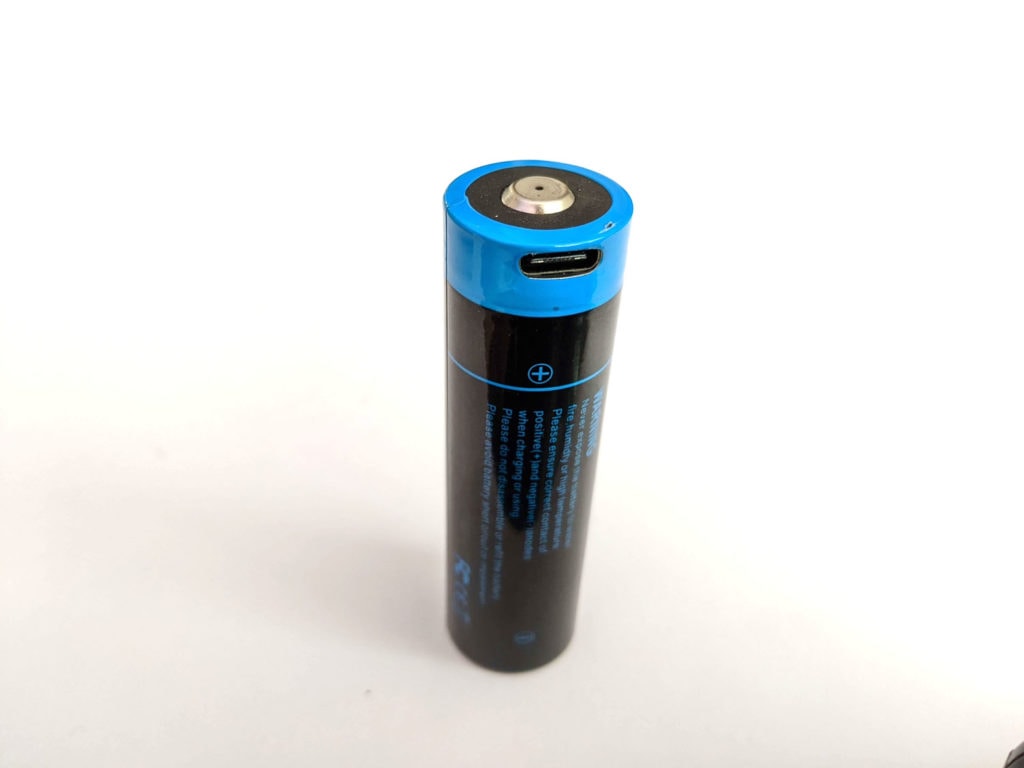
Performance
Lux meter: All lux and lumen measurements are from my home made integrating sphere, calibrated with a range of factory specced lights. Measurements are done with a UNI-T UT383S lux meter and Adafruit TSL2591 connected to a Raspberry Pi (using RuTiTe by bmengineer). Expect them to be within +/-10%.
DMM: Current readings were taken with a Precision Gold PG10B DMM, all with the cell charged to 4.22V.
Measurements here are for the white mode, without any filters.
Amp and lumen measurements
When taking current measurements on turbo, the H3 seemed to notice the increased resistance from the wire and dropped immediately to 1 or 2A.
Most of Cyansky’s numbers were very close to my measurements, with low being the major exception.
| Mode | Current (A) | Spec (lm) | Measured (lm) |
|---|---|---|---|
| Low | 0.02A | 20 lm | 9 lm |
| Medium | 0.48A | 200 lm | 200 lm |
| High | 1.34A | 450 lm | 483 lm |
| Turbo (0s) | 6.99A | – | 1473 lm |
| Turbo (30s) | – | 1300 lm | 1317 lm |
| Turbo (10m) | – | – | 827 lm |
Runtime graph
On turbo the H3 starts off at nearly 1500 lm, which is reasonable for an XHP35 LED. After a few seconds it starts dropping. While I measured it above the 1300lm spec at 30 seconds, it was well below spec just 15 seconds later. I did another run time when the light was slightly warmer and that time it dropped below spec at about 20 seconds.
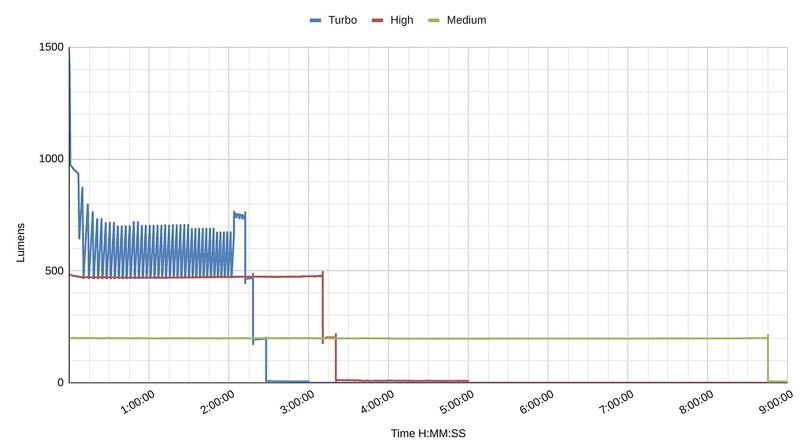
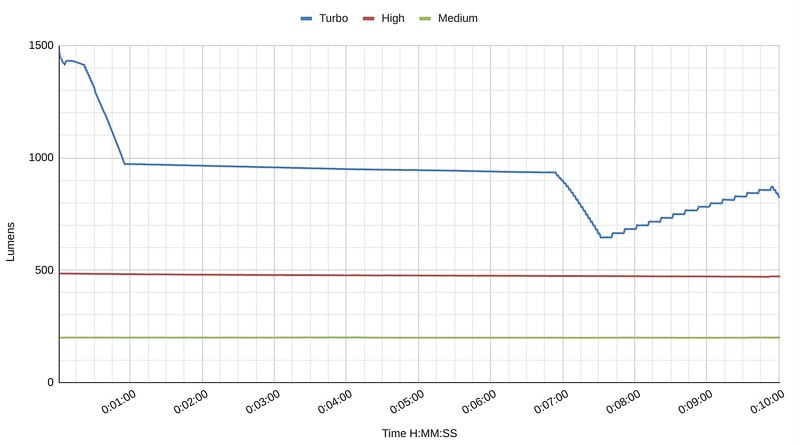
Just like the larger H5, after a minute it settles just under 1000 lm, then after 5 minutes of the flashlight heating up, it starts the sawtooth wave, fluctuating between 500 lm and 700 lm as it tries to hunt for the maximum brightness that isn’t too hot. It’s not ideal but as this happens over a minute or 2 it’s not really noticeable when using the light outdoors. The light lasts a good 2h15m above 500 lm, before it steps down to medium then low.
High is lovely and steady at almost 500 lm for over 3 hours. Medium was perfectly on spec at 200 lm and only dropping down 2 lumens over 8 and a half hours.
Throw numbers:
As with lumen numbers, apart from the low mode, the throw numbers I got were very similar to Cyansky’s.
| Mode | Spec | Measured |
|---|---|---|
| Low | 50m / 625 cd | 23m / 132 cd |
| Medium | 157m / 6121 cd | 158m / 6248 cd |
| High | 235m / 13,806 cd | 243m / 14,774 cd |
| Turbo (0s) | – | 415m / 43,119 cd |
| Turbo (30s) | 400m / 40,000 cd | 408m / 41,628 cd |
Beamshots
Photos were taken with a Pixel 3a, set to 1/2s shutter speed and ISO 400, F1.8. White balance was locked on cool white.
Distance to the bench is 6m, tree on the right is 13m, tree on the centre right is 18m and the building behind it is 69m.
- Convoy M3-C (XHP70.2)
- Convoy S21B (Boost HX)
- Cyansky H3 (XHP35 HI)
- Cyansky H5 (XHP35 HI)
- Sofirn SD05 (XPH50.2)
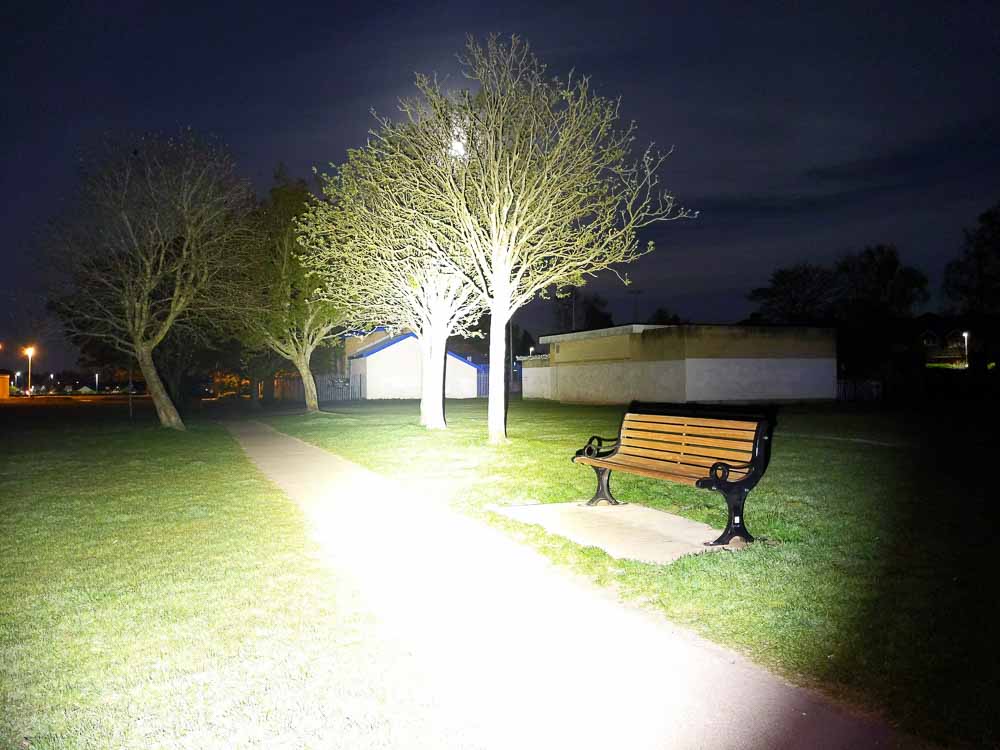
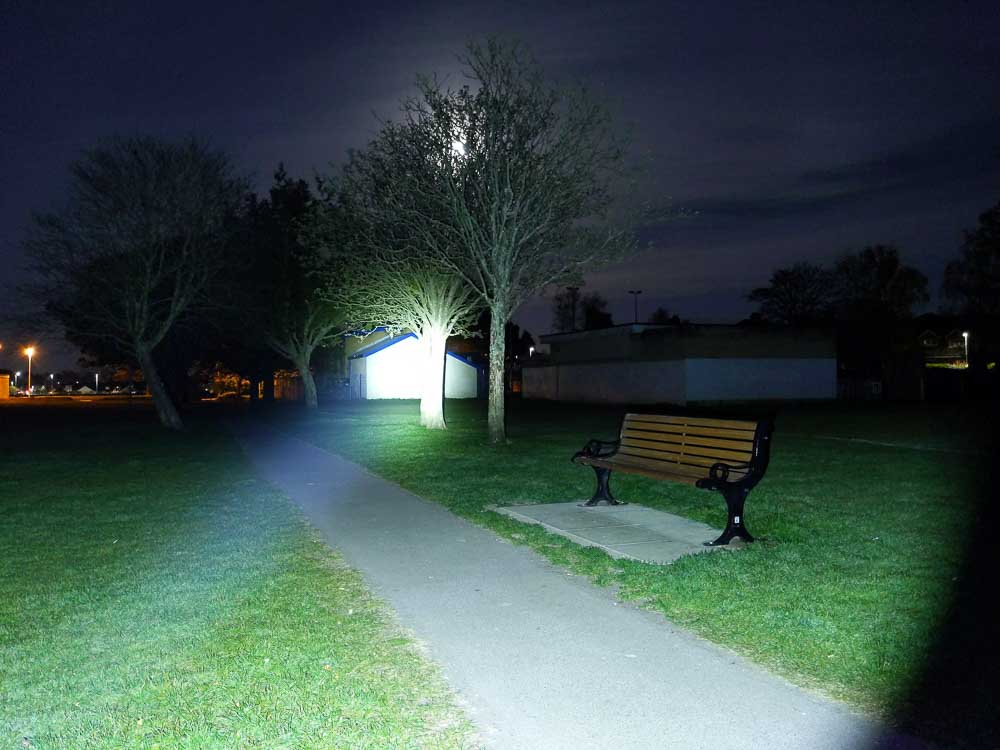
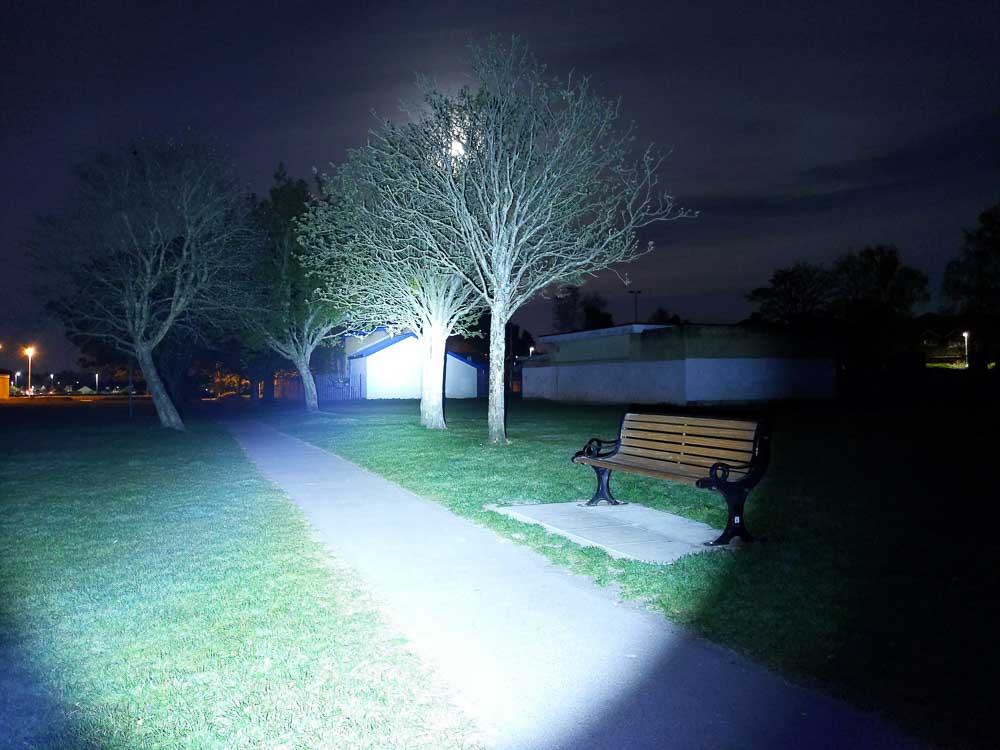
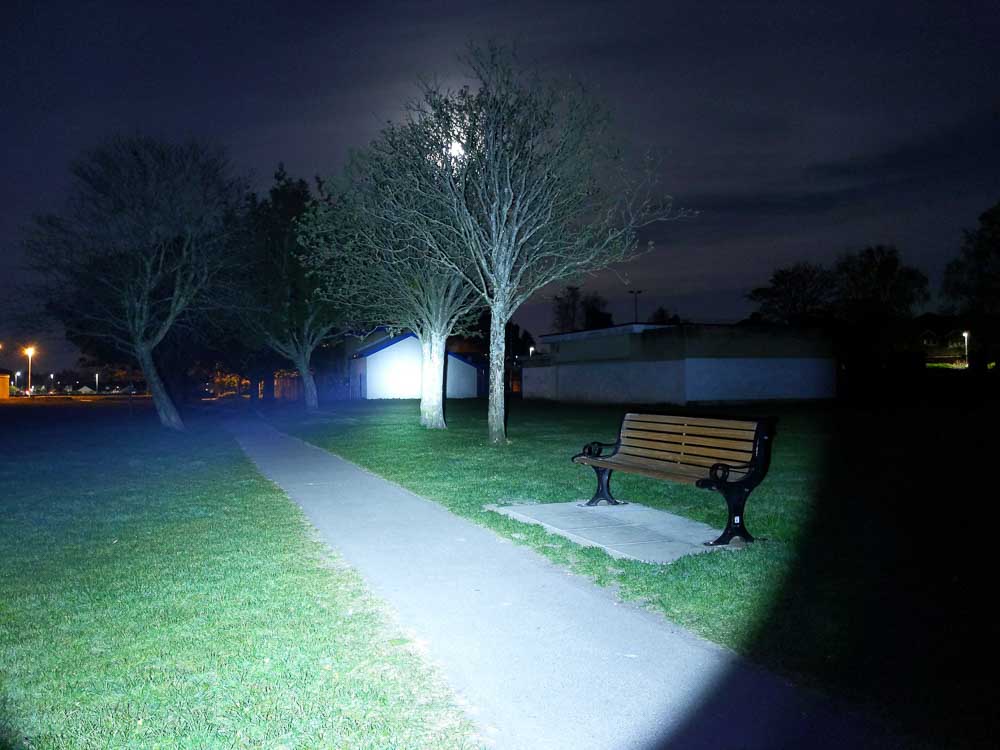
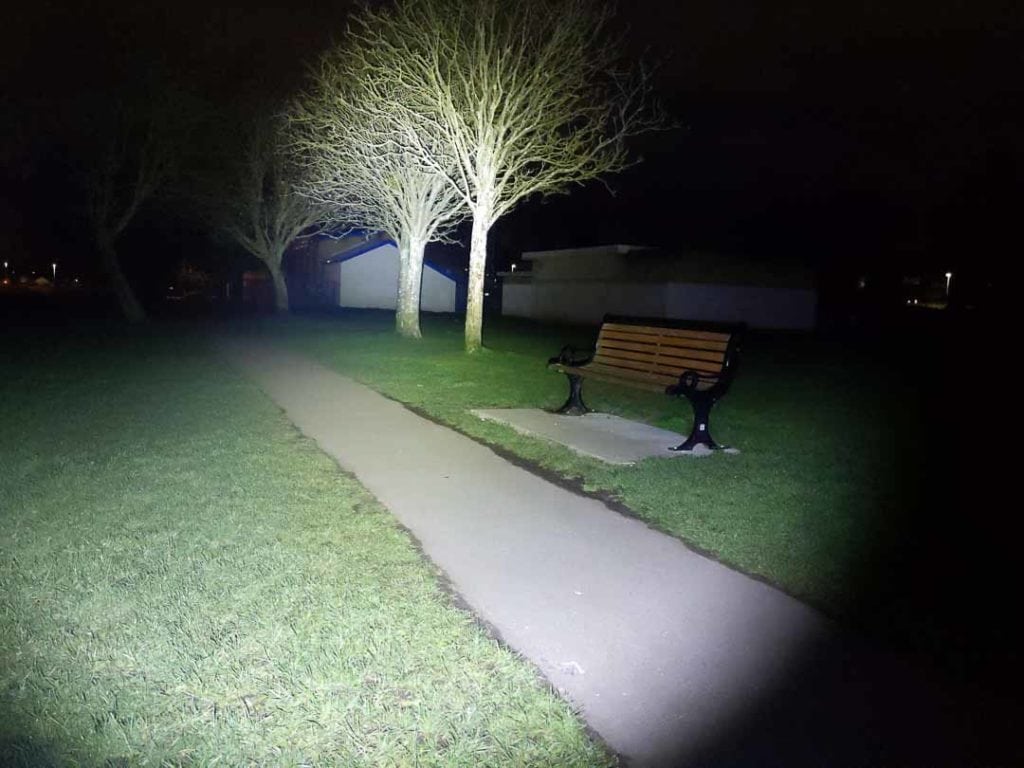
Disclaimer: This flashlight was sent to me for review at no cost by Fresygear. I have not been paid to review, nor have I been holding back on problems or defects.
Explanation on star ratings:
- – Avoid: my phone flashlight would be a better choice
- – Poor: significant defect or issues, much better options available at the same price
- – Average: some defects or issues
- – Good: recommended (minor issues)
- – Great: highly recommended
Final Verdict
Pros
- Color filter mechanism work well
- Simple UI
- Meets lumen specs
Cons
- Run times not quite to spec (but they’re still good)

4.5 stars: ★★★★⋆
The H3 is like a great option if you want a red and/or green light combined with white. Having one LED with filters gives a better beam, more brightness and more throw than having separate LEDs crammed into 1 light. That said, if you want just a red or green light then there’s better flashlights available with higher performance. Such as a Manker, Noctigon or Acebeam flashlights with either red or green Osram emitters.
The H3 is almost identical to the larger H5 so I suppose I better give it an identical score of 4.5. Whilst it’s great for what it is and the colour filters are fun, the H3 just feels a bit… underwhelming.
At 400m throw and 1300 lm, the XHP35 is a good emitter for a well rounded light but it’s mediocre when you compare it to specialised LEDs or flashlights. Perhaps I’ve been spoiled with options but in the same size host you could easily get a 4000 lumen flashlight or one that throws 700m. At 400m the H3 throws further than most EDC lights but still doesn’t throw especially far. If I knew I wanted a thrower then I’d pick something that throws a much longer distance.
If you don’t need the red and green filters, then the Boost HX LED in the Convoy S21B throws further and is just about as bright in a smaller host.
But if you want just 1 light that’s not too big to carry, throws quite far, is still usable at close range and gives you the option of red and green light then the Cyansky H3 is the perfect light for you.
Buy your Cyansky H3 here
1lumen selects and reviews products personally. We may earn affiliate commissions through our links, which help support our testing.